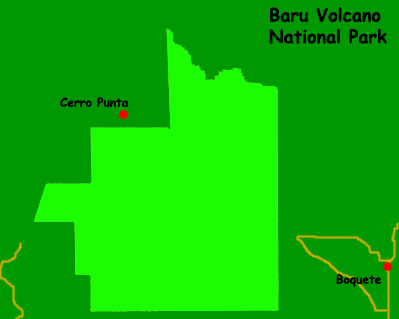 |
 |
 |
 |
The Baru Volcano National Park is 500 kilometers from Panama City in the Province of Chiriqui, on the Cordillera de Salamanca. It covers an area of 14,322.5 hectares. The Volcan Baru National Park was established in 1976 and is the only natural park of Panama with a volcano.
The park can be accessed by car through the towns of Boquete (on the western slopes) and Cerro Puntao (on the eastern slopes). There are hotels in Cerro Punta and Boquete. Trails lead from both towns to the summit of the volcano. The park has an administrative office with an information facility, a forest ranger, a natural trail and two ranger refuges (Repingue and Alto Chiquero)
There is a variety of climate zones - humid montane forest, low humid montane forest, not found elsewhere in Panama, low humid montane rainforest, montane rain forest, very humid low montane forest and premontane rain forest. Average annual temperatures vary between 20º C at the lowest points, to under 10º C on the top of the volcano. The rainfall is less heavy on the lower slopes with an annual average of around 4,000 mm and in the highest points over 6,000 mm.
From the top of the Volcan Baru , which at 3,474 meters high is the highest point in Panama, you can see both the Pacific and the Caribbean Sea and a large of eastern Panama.
The park is the source of important rivers like the River Caldera, whose waters generate hydroelectric power for the entire country.
Over 250 species of birds have been recorded in the park, including the quetzal, the black-and-white hawk-eagle, black-bellied hummingbird, black-cheeked warbler, different varieties of torcazas and the brown violet ear. The hairy woodpecker can be watched during the months of April and May. You will also find endemic species from the Cordillera de Talamanca, like the wrenthrus, yellow thighed finch and black guan.
Amphibians and reptiles like the iguanas Anolis vociferans and Anolis fungosus has been identified at Baru cloudy forest
Mammals. The five cat species that live in Panama are also present here, with the puma or leon venado, one of the most numerous. Other mammals from endangered species include the mouse (Rheomys underwood), the porcupine; and a large number of bat species including Artibeus aztecus and Lisiurus borealis.